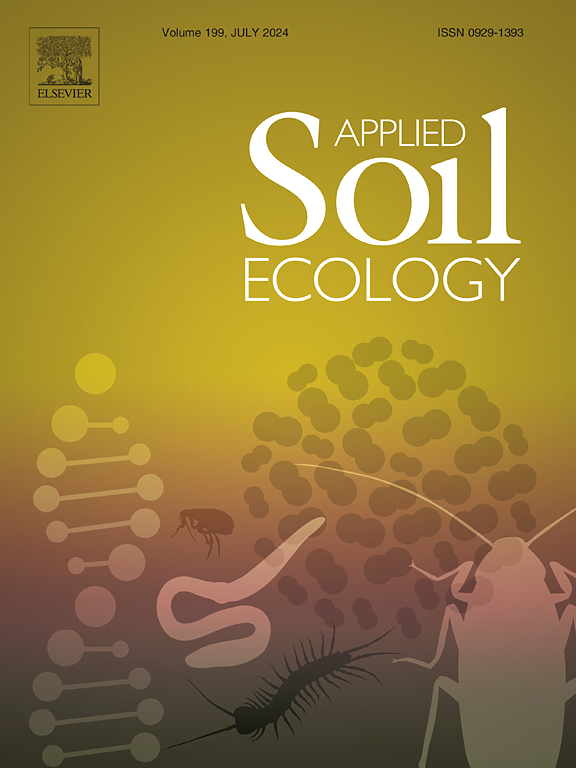Earthworm inoculation in degraded soils: A meta-analysis
IF 4.8
2区 农林科学
Q1 SOIL SCIENCE
引用次数: 0
Abstract
Earthworms are key soil organisms involved in several soil functions. Earthworm inoculation can be used in the context of the agroecological transition and of Nature-based solutions to produce food while restoring soil fertility. In this meta-analysis we wanted to identify the earthworm inoculation parameters (density of the inoculated earthworms, time between inoculation and sampling, presence/absence of physical barriers, and number of species inoculated) that lead to a successful intervention (earthworm abundance and biomass increase).
For this quantitative analysis of earthworm inoculation success, we exhaustively reviewed the literature using the ISI Web of Knowledge with the “All Databases” option. We selected articles on field experiments that compared earthworm abundance or biomass in the inoculated area and in a clearly defined control area (same sampling period). We excluded articles on laboratory studies, vermicomposting, and non-intentional earthworm introduction.
Based on the 25 studies included in the corpus, the meta-analysis showed an increase in the abundance of inoculated earthworm species (4.48-fold) and of the whole earthworm community (1.55-fold). When >150 individuals m−2 were inoculated, the abundance of the inoculated earthworm species increased by a factor of 48.0 compared with the control plot. By monitoring the efficiency after at least 2 years, the increase in inoculated species abundance reached a factor of 37.0. Conversely, in short-term studies (<1 year), this increase factor was not significant and was reduced to 1.9. Multi-species inoculations (i.e., different ecological categories of earthworms) could be more efficient (inoculated species abundance and total community biomass increases by a factor of 30.3 and 3.6, respectively). In a soil restoration perspective, an efficient inoculation must be designed in function of the targeted soil functions.
To perform a successful inoculation, we recommend to inoculate >150 individuals m−2, preferably of different species, and to assess their establishment after a relatively long interval (>2 years after inoculation).
退化土壤中的蚯蚓接种:荟萃分析
蚯蚓是关键的土壤生物,参与多种土壤功能。蚯蚓接种可用于农业生态转型和基于自然的解决方案,在生产粮食的同时恢复土壤肥力。在这项荟萃分析中,我们希望确定导致成功干预(蚯蚓数量和生物量增加)的蚯蚓接种参数(接种蚯蚓的密度、接种与取样之间的时间间隔、物理障碍的存在/不存在以及接种物种的数量)。为了对蚯蚓接种的成功率进行定量分析,我们使用 ISI 知识网的 "所有数据库 "选项详尽查阅了相关文献。我们选择了实地实验方面的文章,这些文章比较了接种区域和明确界定的对照区域(同一采样期)的蚯蚓数量或生物量。我们排除了有关实验室研究、蚯蚓堆肥和非故意引入蚯蚓的文章。根据语料库中的 25 项研究,荟萃分析表明,接种蚯蚓物种的丰度增加了 4.48 倍,整个蚯蚓群落的丰度增加了 1.55 倍。当接种 150 m-2 的个体时,接种蚯蚓物种的数量比对照小区增加了 48.0 倍。通过至少两年后对效率的监测,接种物种数量的增加达到了 37.0 倍。相反,在短期研究(1 年)中,这一增加系数并不显著,降至 1.9。多物种接种(即不同生态类别的蚯蚓)可能更有效(接种物种丰度和群落总生物量分别增加了 30.3 倍和 3.6 倍)。为了成功接种,我们建议接种 150 m-2 的蚯蚓个体,最好是不同种类的蚯蚓,并在较长的间隔期(接种后 2 年)后评估它们的建立情况。
本文章由计算机程序翻译,如有差异,请以英文原文为准。
求助全文
约1分钟内获得全文
求助全文
来源期刊

Applied Soil Ecology
农林科学-土壤科学
CiteScore
9.70
自引率
4.20%
发文量
363
审稿时长
5.3 months
期刊介绍:
Applied Soil Ecology addresses the role of soil organisms and their interactions in relation to: sustainability and productivity, nutrient cycling and other soil processes, the maintenance of soil functions, the impact of human activities on soil ecosystems and bio(techno)logical control of soil-inhabiting pests, diseases and weeds.
 求助内容:
求助内容: 应助结果提醒方式:
应助结果提醒方式:


